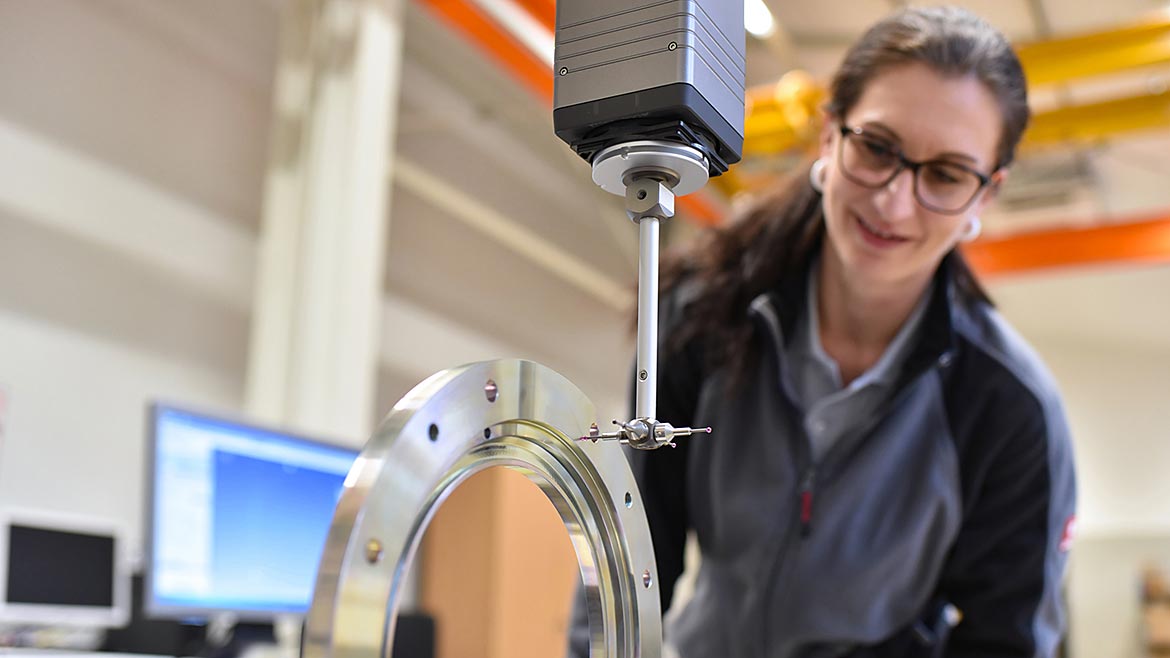Management
AI’s Double-Edged Sword: Security and Compliance in Manufacturing
Without human oversight, AI tools have the potential to generate risks.

Image Source: industryview / iStock / Getty Images Plus
More than half (55%) of organizations plan to adopt Generative AI for security this year, indicating a drastic increase in its use within sensitive business operations. Joining the surge in adoption is manufacturing, which is an industry adopting AI at a rapid pace. While AI undoubtedly creates an opportunity for greater efficiency, cost savings and precision, its rapid integration and orchestration exposes organizations to new security risks and regulatory challenges.
Poor data governance, security posture and regulatory missteps can quickly escalate into financial and legal consequences. Manufacturers must take a proactive approach to ensure AI’s benefits don’t come at the expense of operational stability.
The Expanding Role of AI in Manufacturing
AI is reshaping manufacturing in multiple ways. Predictive maintenance, automated quality control and real-time supply chain monitoring are just a few of the applications driving efficiency and cost savings. AI-powered vision systems enhance defect detection, machine learning optimizes production scheduling and robotic process automation (RPA) streamlines repetitive tasks. However, despite these advantages, AI adoption is not without risk.
A recent survey conducted by Researchscape found that 77% of manufacturers have now implemented some form of AI into their business operations. However, while being bullish on AI, the survey respondents also worry about their infrastructure’s ability to manage new security concerns. Nearly half (45%) of respondents cited a lack of internal expertise, while some pointed to difficulty integrating AI with existing systems (44%) – persistent challenges that continue to raise concerns as adoption accelerates across the industry.
So, where does the problem lie? At inception. The speed at which AI is deployed means many companies implement solutions before establishing governance frameworks to effectively manage risks. This creates vulnerabilities that can affect the very fabric that keeps manufacturing running, such as disrupting operations, leading to regulatory penalties or exposing sensitive business data to cyber threats.
The Risks of AI in Manufacturing: Compliance, Security, and Accuracy
Without human oversight, AI tools have the potential to generate risks. These same risks have caused concerns among some manufacturing professionals, especially regarding perceived threats like taking over their jobs amid the industry’s current labor crisis (622,000 open jobs). Additional risks that are prompting some professionals to pump the brakes on automatic AI deployment include the following:
Inaccurate Outputs and Flawed Decision-Making
AI models are only as good as the data they are trained on or have access to. AI-generated insights may be unreliable or misleading if training data is incomplete, biased or outdated. For instance, a machine learning model designed to detect product defects might fail to identify new flaws if not regularly updated. This can lead to increased waste, costly recalls or even regulatory action if non-compliant products enter the market.
In another example, AI-powered supply chain forecasting can become problematic if historical data does not reflect changing market conditions. Manufacturers that over-rely on AI-generated demand predictions without human oversight risk excess inventory or production slowdowns, leading to revenue loss. The key is ensuring continuous validation and auditing of AI models to maintain accuracy and reliability.
Security Posture: AI as a Target for Cyberattacks
Manufacturers process vast amounts of proprietary data, including product designs, production techniques and supply chain logistics. AI systems that handle this data can become prime targets for cyberattacks. Threat actors may manipulate AI models by injecting false data, leading to compromised decision-making. Additionally, hackers exploiting AI vulnerabilities could gain unauthorized access to industrial control systems, creating severe operational disruptions.
Deepfake technology and AI-generated phishing attacks are emerging threats that further complicate cybersecurity efforts. Attackers may exploit AI-powered chatbots and virtual assistants used in manufacturing to trick employees into revealing sensitive information. Without strong security protocols, AI can become a liability rather than an asset.
Regulatory Misalignment: Decoding the Complexities of AI Governance
As AI becomes more embedded in industrial operations, regulatory bodies worldwide are enacting stricter compliance requirements. New AI-specific regulations mandate transparency, data privacy and accountability in AI decision-making. Manufacturers that fail to comply with evolving standards face legal penalties, operational restrictions or reputational damage.
For example, the European Union’s AI Act categorizes AI applications based on risk levels, with stringent requirements for high-risk AI systems, including those used in critical manufacturing operations. In the U.S., while AI-specific legislation remains under development, existing privacy and data protection regulations already impact AI-driven operations. Given AI’s reliance on large amounts of data, an organization’s governance strategies must align with privacy regulations to mitigate compliance risks.
Proactive AI Governance: Four Strategies for Risk Management
A structured governance approach is essential for mitigating AI risks. Organizations must establish clear policies to manage AI development, deployment and monitoring while integrating security and compliance measures. The following strategies can help manufacturers protect their AI investments and ensure sustainable adoption.
1. Centralized Risk Management
Manufacturers deploying AI across various departments (production, quality control, supply chain, etc.) require a holistic view of potential risks. A centralized governance, risk and compliance (GRC) system provides this oversight. It acts as a single source of truth for all AI-related risk information, enabling consistent tracking and enforcement of standardized controls. This includes:
- Risk assessment frameworks should be dynamic and adaptable to the evolving nature of AI. They should identify potential vulnerabilities before deployment, considering factors like data quality, model bias, adversarial attacks and unintended consequences.
- Incident response plans must address AI-driven security breaches, which can differ from traditional IT incidents. They should outline procedures for containment, eradication, recovery and post-incident analysis.
- Meticulous documentation is essential for demonstrating regulatory compliance (e.g., GDPR, CCPA) and internal accountability. This includes documenting data sources, model training processes, validation results and any changes made to the AI system over time.
2. Automated Compliance Monitoring
Real-time compliance monitoring and reporting are essential due to evolving regulations. Automated compliance tools can:
- Provide full visibility into compliance status and scan for potential violations.
- Generate reports on regulatory adherence.
- Alert executives and stakeholders to compliance risks before they escalate.
This proactive approach helps reduce penalties, prevent disruptions and build trust by ensuring data privacy, bias detection, explainability and security. Integrating this into AI governance is crucial to establishing responsible AI deployment. Manufacturers reduce the risk of regulatory penalties and operational disruptions by integrating compliance monitoring into AI governance.
3. Continuous Data Validation and Model Auditing
GenAI and AI product outputs require scrutiny for data integrity and adherence to fairness, bias and regulatory standards. To break through AI’s “black boxes,” there are best practices businesses can adopt for AI model auditing, including:
- Testing AI systems against real-world scenarios to detect biases and inaccuracies.
- Updating training datasets to reflect current industry conditions.
- Implementing feedback loops where human experts review AI decisions for accuracy.
Ongoing validation processes ensure that AI remains a reliable tool rather than a source of misinformed decision-making.
4. Cybersecurity-First AI Deployment
As AI becomes more deeply embedded in business operations, ensuring its security from the ground up is critical. AI systems process vast amounts of sensitive data, making them attractive targets for cybercriminals seeking to manipulate algorithms, extract proprietary insights or launch sophisticated attacks. Organizations must adopt a cybersecurity-first mindset when deploying AI to protect the integrity of AI-driven processes and the data they rely on.
This proactive approach mitigates security risks by embedding protective measures directly into AI development and deployment rather than treating security as an afterthought. Key tactics include:
- Meticulously monitoring processes and data for changes associated with onsite, homegrown and third-party AI systems.
- Encrypting AI-generated data to prevent unauthorized access.
- Implementing multi-factor authentication for AI tools handling sensitive information.
- Restricting AI model training to verified datasets to reduce manipulation risks.
- Implementing custom guardrails to prevent harmful outputs, mitigate bias, protect data privacy and comply with regulations.
AI security should be an integral component of any company’s overall cybersecurity strategy, preventing vulnerabilities from being exploited by bad actors.
Outlook: AI Risk Management as a Competitive Advantage
AI’s integration into manufacturing is accelerating, but its risks must be managed effectively to unlock its full potential. Companies that proactively implement AI governance within a centralized GRC system will gain a competitive edge by ensuring reliability, regulatory compliance and security across production, quality control and supply chain operations.
Organizations that do not take a proactive approach risk undermining their AI strategies and exposing themselves to costly compliance violations and security threats. As AI continues to reshape manufacturing, businesses that embed governance and risk controls into their AI strategies will be best positioned for a secure, sustainable and prosperous future.
Looking for a reprint of this article?
From high-res PDFs to custom plaques, order your copy today!





